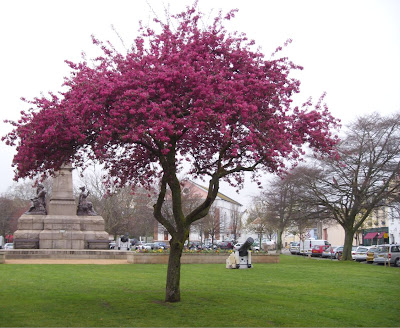Daniel Austin’s new play ‘in-the-making’ was inspired by Continuum: Blanket Stories an exhibition by Marie Watt at the National Museum of the American Indian in New York in autumn 2004, which I also saw.
 |
| Marie Watt: Blanket Stories |
Her twisting columns of blankets were immediately striking because of the familiarity of the objects together with their unusual display, evoking totems and storybook ladders to the sky, as well as all the connotations of the blankets themselves – of warmth, comfort, community, intimacy, honour, ritual, memory and above all stories – gifted and gathered from thrift stores they might have been given in friendship, wrapped around the newly born and the dead, or traded between settlers and indigenous weavers. They represented a link between past and present generations and their scents and signs of wear, the moth holes and cigarette burns and distortions (as if taking the shape of their owners) might have been clues to their stories.
Walking into St James this evening to see a giant tipi almost perfectly fitting the central space can only be described as magical.
The piece of theatre is presented by four young performers, who have spent the last week or two with Daniel experimenting and creating its 24 ‘blankets’.
 |
| photo: Daniel Austin |
The piece of theatre is presented by four young performers, who have spent the last week or two with Daniel experimenting and creating its 24 ‘blankets’.
These encompass poems, storytelling, film projected onto the canvas sides of the tipi, readings such as the Universal Declaration of Human Rights and found material from current newspapers (including in this performance humorous comment on the Royal Wedding and Aung San Suu Kyi on her father: ‘parents would take their children up in their arms and say, “Look! This is Grandfather Aung San’s daughter” from The Guardian) as well as many beautiful blankets and quilts and ‘treasured’ objects brought in by audience members (which this evening included childhood toys, photos, jewellery and an intriguing notebook from 1941).
I particularly liked the description of the ‘spirit line’, the deliberate flaw introduced by Navajo weavers so that their work would not be perfect, a concept antithetical to typical Western notions of art.
The piece avoids being too, what Daniel referred to as, ‘earnest’, by using a wide range of universal material, such as Martin Luther King’s ‘I have a dream’ speech, by a freshness in the performances - particularly from the youngest cast member who, at nine, is still naturally inquisitive and playful, by the beautiful simplicity of American Indian poetry which encourages almost a meditative mood, but also through the physical embodiment of a work that is part installation, part site sensitive.
This almost homespun physicality is the play’s greatest strength. With the audience seated in a circle in the tipi, a real sense of community and intimacy is created. Objects are passed around and blankets displayed and a space for sharing created where new stories might evolve or be disclosed – evoking a sense of past times and of the handing down of memories between generations.
This was a first showing of a play still at the experimental and ‘playful’ stage prior to a longer run - 28 June to 2 July at St James, which I look forward to experiencing again.


